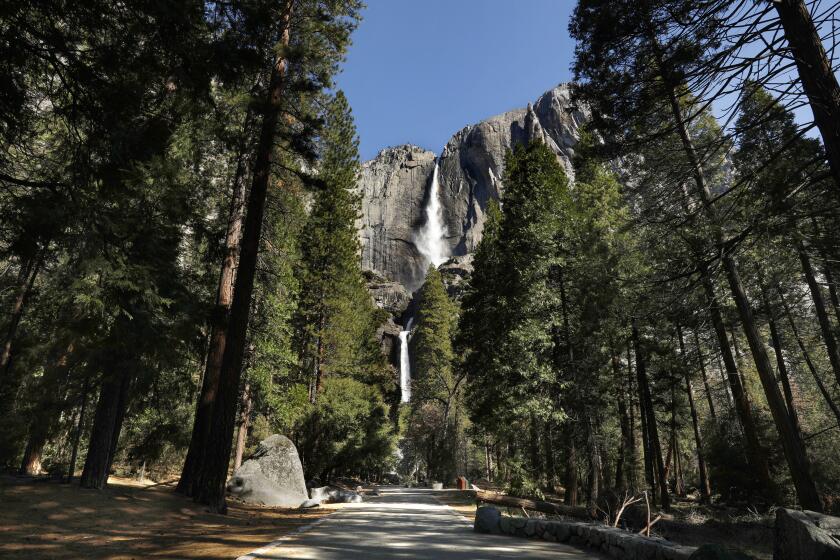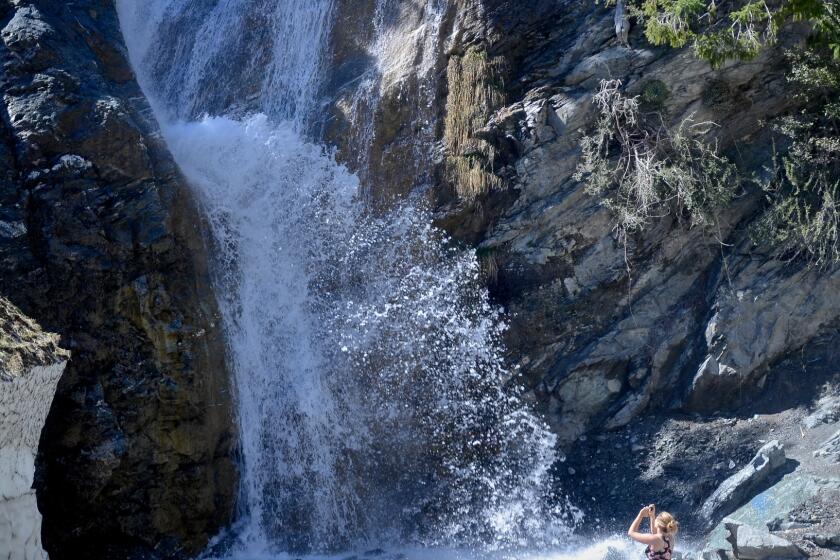Joshua Tree just opened, before a three-day weekend. Here’s what to expect
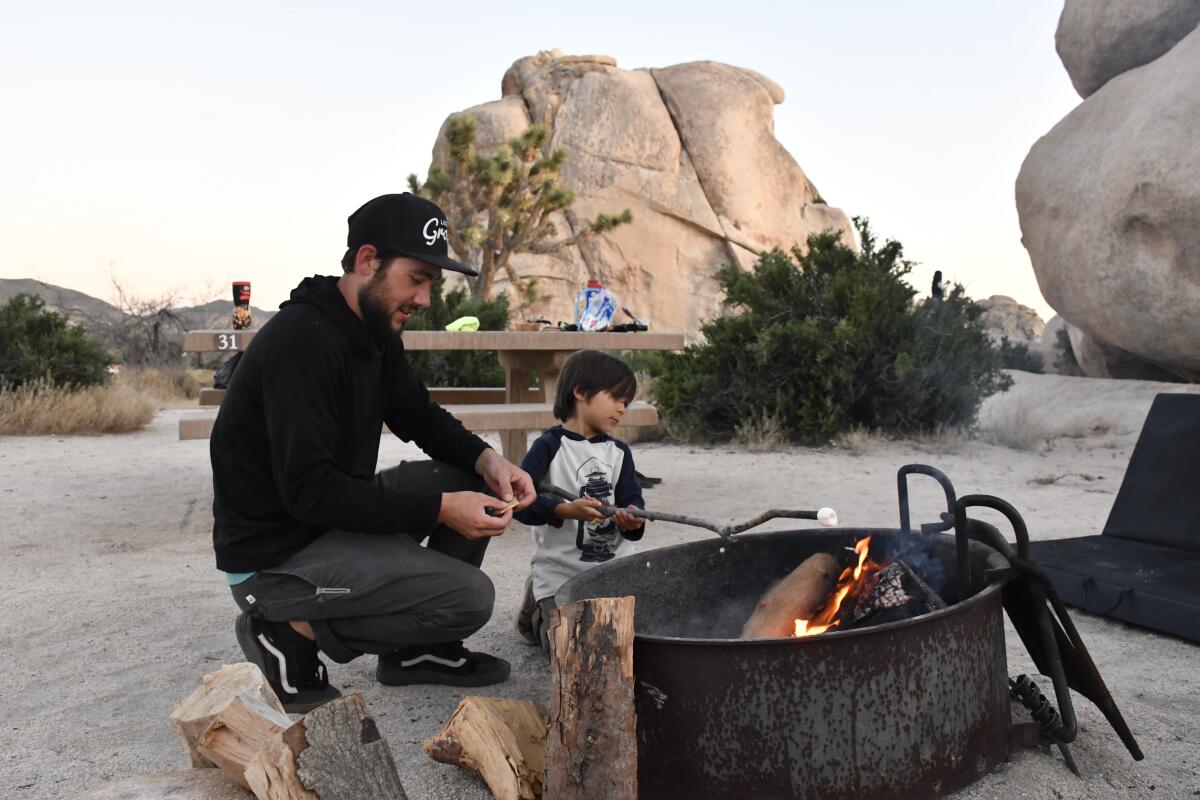
- Share via
JOSHUA TREE NATIONAL PARK — This park’s reopening has set off a race to the desert among hundreds of hikers, climbers and adventure-starved families rushing to grab up the park’s 520 camping spots before the temperature climbs in coming days.
Rangers say this influx, which began with Sunday’s low-profile reopening and picked up steam Tuesday and Wednesday, is manageable so far. But it may be the beginning of a hot, busy, complicated Memorial Day weekend.
With a three-day weekend before them, Southern Californians will have to weigh the lure of desert vistas against the chance of crowds and the challenge of rising temperatures, expected to reach the 90s by Tuesday.
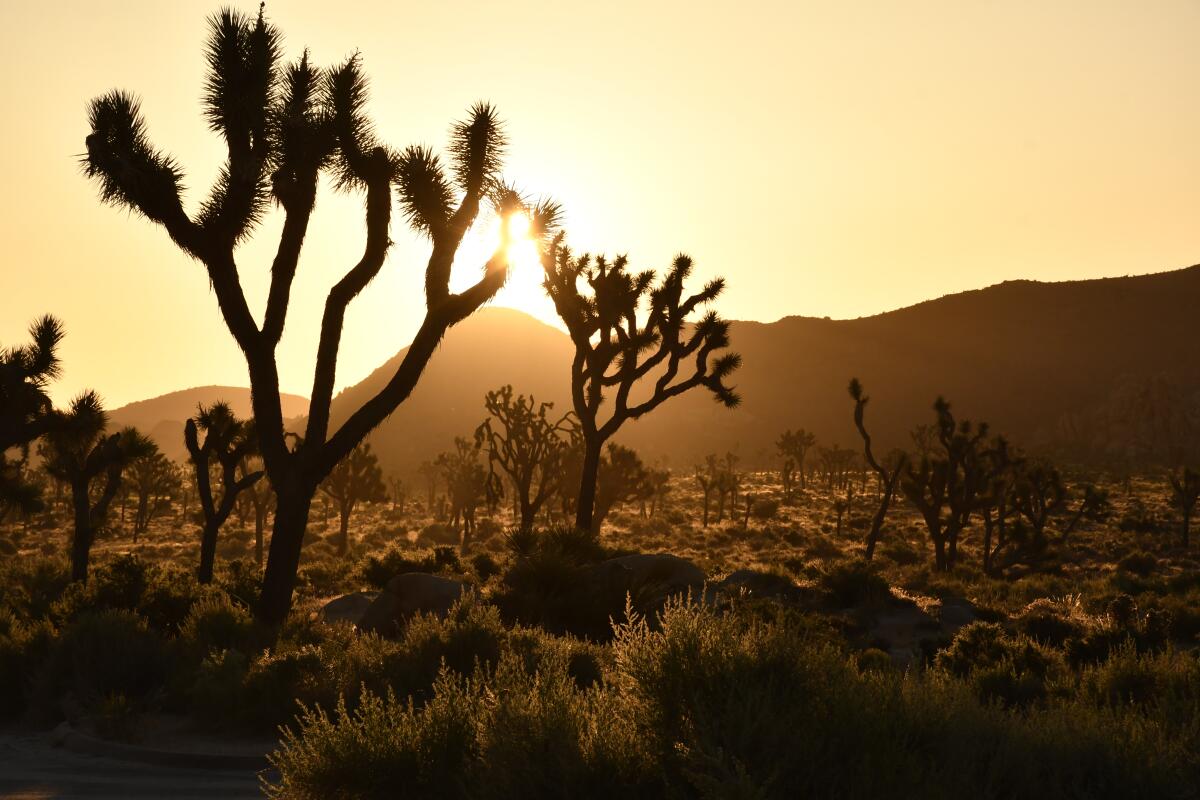
Rangers will be managing a park whose roads, trails and individual campgrounds are open but whose three visitor centers and group campgrounds are closed.
“The increasing access has gone well so far,” said park spokeswoman Hannah Schwalbe, who added that rangers will encourage visitors to be safe and follow guidance from the national Centers for Disease Control and Prevention, the state and the county health department.
Get The Wild newsletter.
The essential weekly guide to enjoying the outdoors in Southern California. Insider tips on the best of our beaches, trails, parks, deserts, forests and mountains.
You may occasionally receive promotional content from the Los Angeles Times.
“I had to get out of the city. Bay area. It’s crazy,” Zack Bloom said as he arrived, rolling past one already-claimed Hidden Valley campsite after another. Bloom said he set out for the desert Tuesday, slept in his car on the way and arrived Wednesday afternoon.
His goal: “Commune with nature.”
Many campers said they had canceled more ambitious trips that had been scheduled this month. When word spread that Joshua Tree was opening, it began to look like an 800,000-acre consolation prize.
Lodgings and some campgrounds would reopen under a draft plan that still requires approval from the state and the feds.
“We were so bored and itching to go somewhere,” said Ydris Hicks of Carlsbad, who was keeping a volleyball aloft with his roommate, Courtney McClane. “Last night, we learned this was open.”
His plan: Sleep under the stars and climb in the morning. In terms of virus risk, he said, “this is the same as sitting in your house. But we haven’t slept outside of our house in a while.”
Though the park’s coveted Hidden Valley Campground had only a few empty sites Wednesday night, many other camping areas, including Jumbo Rocks, were more than half empty.
Campers savored the chance to see the park in spring, without big crowds (so far) after weeks of enforced time at home. Many brought children.
Only a handful of visitors wore face coverings in camp or out and about. San Bernardino County, which includes the park, strongly recommends face coverings in public but is no longer requiring them.
Cory and Becky McPherson came from Long Beach with their sons, Benjamin, 7, and Kai, 15 months, after Becky spotted the reopening announcement on Instagram.
“We packed up and came out here the same day,” said Cory, whose film production work is on hold. Because Benjamin is home-schooled, McPherson said, they didn’t have to worry about virtual school.
As the sun set Wednesday, the McPhersons were roasting marshmallows at a fire ring in the Hidden Valley Campground. A few campsites away, Holly Hirschi and Edgar Carrillo of San Diego were pulling out their marshmallows as well.
“I’m starting grad school in the fall, so I’m not working right now. And Edgar had a sabbatical at work,” Hirschi said.
In fact, their original plan was to be on a three-state, six-park camping vacation.
Amid coronavirus restrictions, tips for walking, hiking, cycling, running near home
“We would actually be in Oregon, at Crater Lake, right now,” Carrillo said.
As for the threats posed by a park visit, Hirschi said she didn’t see big issues. “There’s pretty minimal contact with people,” she said.
None of Joshua Tree’s public programs is being offered, but campers are required to pay on the spot with cash or a check, $15 to $20 per campsite per night.
Entrance fees (usually $30 per vehicle) will be enforced starting Friday, Schwalbe said.
Most bathrooms are open, but water sources in the park are few. Many campgrounds have no potable water sources, so best to bring your own.
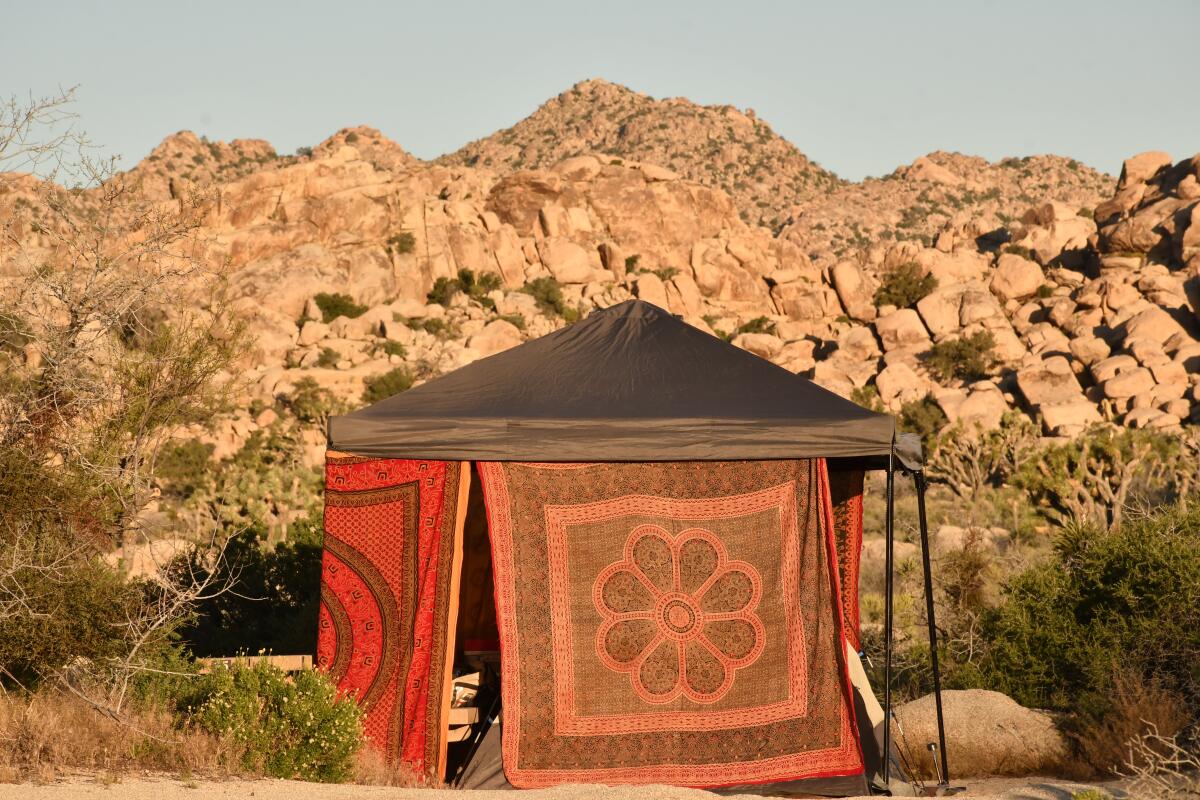
Many of the park’s campsites are typically snapped up in spring through reservations made at recreation.gov. But in the move to reopen, park officials and concessionaires decided to cancel all reservations and offer all campsites on a first-come, first-serve basis through Sept. 3.
On Thursday, that meant early arrivals had a nearly pristine park to themselves. Hikers had the rare opportunity to inspect Skull Rock with almost no human company. (Rabbits and lizards, however, were plentiful.)
Ranger Devann Miles said she was braced for “a surplus of people, but you never know.”
With crowds in mind, rangers have planned for one-way traffic on at least two of the park’s busiest loop trails, Barker Dam and Hidden Rocks. However many visitors arrive for the weekend, she said, “people just need to go slow, because of the snakes and the tortoises.”
Nearby on the park’s main road, Wanda and Rick Bogin were on their bikes, hoping to put in a 40-mile ride.
The two, who run a group tour business, were supposed to be leading groups in New Orleans and New York, respectively, this week. Instead, they said, they’re still at their winter home in La Quinta because this season’s trips had been canceled. So they seized the opportunity to make a day trip to the park.
“It’s just too beautiful not to be here,” said Rick Bogin.
“We’re trying to make lemonade out of it,” said Wanda Bogin. “And hopefully, we’ll see a desert tortoise today.”
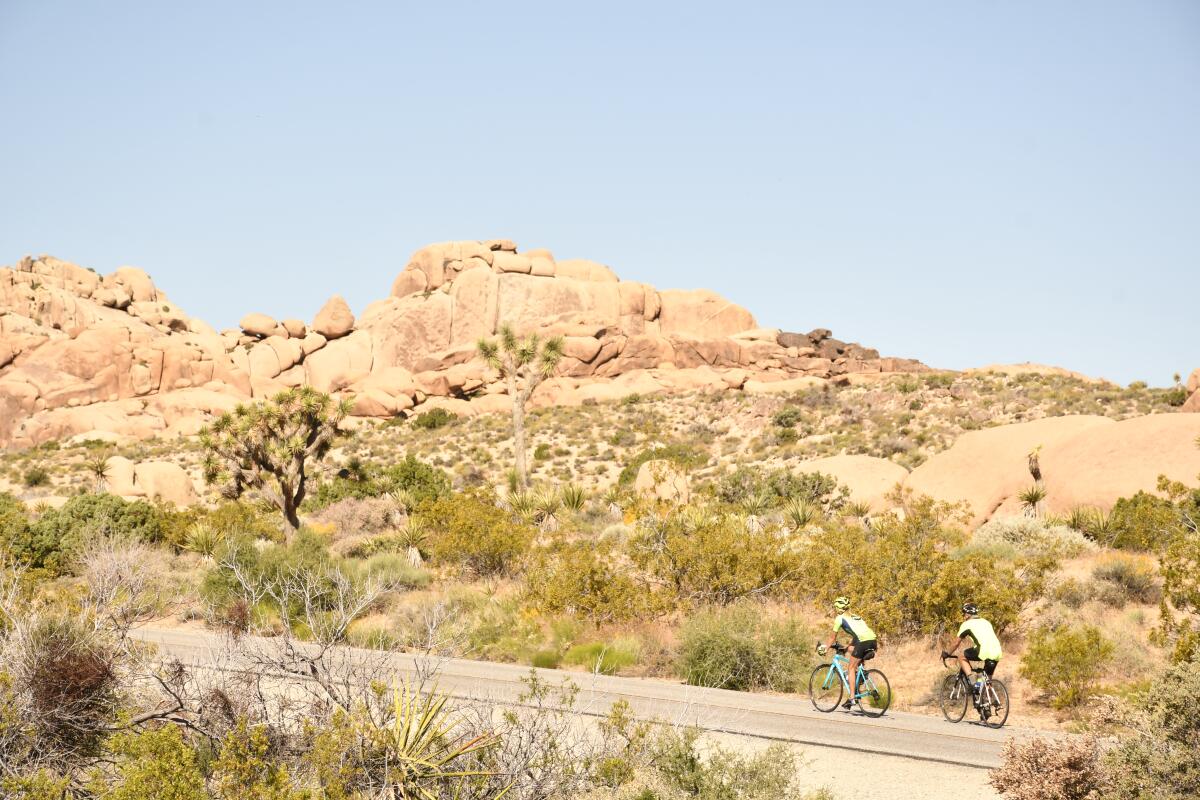
More to Read
Sign up for The Wild
We’ll help you find the best places to hike, bike and run, as well as the perfect silent spots for meditation and yoga.
You may occasionally receive promotional content from the Los Angeles Times.
